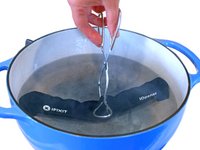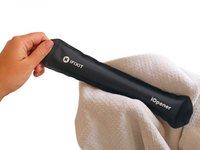Introduzione
L'iOpener è una borsa termica che ritiene il calore, essa può essere scaldata nel microonde e utilizzata per trasferire il calore sull'adesivo lungo i bordi di un iPad o dispositivi simili.
Segui queste semplici istruzioni per cominciare a utilizzare il tuo nuovo iOpener (nero e riempito di liquido). Per l'iOpener bianco e solido, segui invece questa guida.
Per istruzioni specifiche per il tuo dispositivo e la tua riparazione, da' un'occhiata alla nostra serie di guide di riparazione iPad.
Cosa ti serve
-
-
-
Riempi una pentola o una padella con abbastanza acqua per immergerci un iOpener.
-
Scalda l'acqua finché non bolle. Spegni il fuoco.
-
Posiziona l'iOpener nell'acqua calda per 2-3 minuti. Assicurati che l'iOpener sia completamente immerso nell'acqua.
-
Usa delle pinze per estrarre l'iOpener scaldato dall'acqua calda.
-
Asciuga accuratamente l'iOpener con un asciugamano.
-
Il tuo iOpener è pronto all'uso! Se devi scaldare di nuovo l'iOpener, scalda l'acqua fino all'ebollizione, spegni il fuoco e immergi l'iOpener in acqua per 2-3 minuti.
-
Per rimontare il tuo dispositivo, segui queste istruzioni in ordine inverso.
Per rimontare il tuo dispositivo, segui queste istruzioni in ordine inverso.
Annulla: non ho completato questa guida.
Altre 348 persone hanno completato questa guida.
Un ringraziamento speciale a questi traduttori:
100%
Questi traduttori ci stanno aiutando ad aggiustare il mondo! Vuoi partecipare?
Inizia a tradurre ›
56 Commenti
I do not have a microwave because I think it is unhealthy for food preparation. When I need fastfood I often just eat raw fruit which is much faster, healtier, and tastier than most microwave foods.
Does the iOpener Heating also work when it is baked in a frying pan?
Hello! Thanks for the good question. Actually we dissuade from using a frying pan to heat the iOpener because the coating would melt. Instead, use a saucepan filled with cold water and heat it on the stove. But be very careful not to overheat the iOpener and not to hurt yourself handling with the hot iOpener! You can do as well without iOpener and alternatively use a hairdryer to heat directly the device you want to open. Good fix!
You are aware thought that there are no proven side effects of microwaving your food though right? A microwave isn’t inherently unhealthy. I think it helps to look at how a microwave works. A microwave oven heats food by passing microwave radiation through it. While microwave radiation sounds scary its really not. Microwaves are a form of non-ionizing electromagnetic radiation. Non ionizing meaning that it doesn’t make stuff radioactive. Water, fat, and other substances in the food absorb energy from the microwaves in a process called dielectric heating. The water molecules are electric dipoles, meaning that they have a positive charge at one end and a negative charge at the other, and so they rotate as they try to align themselves with the alternating electric field of the microwaves. The friction of the incredibly fast movement heats up the various molecules. Sometimes microwaves are in fact healthier and safer than there counterparts, because the microwave heats food quickly, the nutrients have less time to seep into the water making it more nutrient filled when compared to alternatives. Also, steamed vegetables tend to maintain more nutrients when microwaved than when cooked on a stovetop.
[All sources can be found https://en.wikipedia.org/wiki/Microwave_... at the bottom of the wikipedia page]
nithin -
Its actually halarious that hes like “sure thing! Fry that thing up, lol…gotta put some water down, …but yeah…lmao…too funny
And much more expensive.














